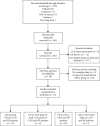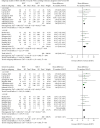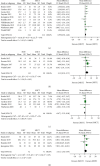The Effects of High-Intensity Interval Training on Exercise Capacity and Prognosis in Heart Failure and Coronary Artery Disease: A Systematic Review and Meta-Analysis
- PMID: 35801132
- PMCID: PMC9203221
- DOI: 10.1155/2022/4273809
The Effects of High-Intensity Interval Training on Exercise Capacity and Prognosis in Heart Failure and Coronary Artery Disease: A Systematic Review and Meta-Analysis
Abstract
Objective: The purpose of this study is to compare the effects of high-intensity interval training (HIIT) versus moderate-intensity continuous training (MICT) on exercise capacity and several prognostic markers in patients with coronary artery disease (CAD) and heart failure (HF).
Methods: This systematic review is registered on the INPLASY website (number: INPLASY202080112). We conducted a comprehensive search in eight databases of literature before September 13, 2019. Trials comparing HIIT and MICT in participants with CAD or HF aged 52-78 years were included. Exercise capacity (peak oxygen consumption (peak VO2)) and prognostic markers, such as the anaerobic threshold (AT), minute ventilation/carbon dioxide production (VE/VCO2) slope, left ventricular ejection fraction (LVEF), and prognostic value of the predicted VO2 max per cent (the predicted VO2 peak (%)) were examined.
Results: A total of 15 studies were included comprising 664 patients, 50% of which were male, with an average age of 60.3 ± 13.2 years. For patients with CAD, HIIT significantly improved peak VO2 values (95% CI 0.7 to 2.11) compared with MICT, but peak VO2 values in patients with HF did not seem to change. For training lasting less than eight weeks, HIIT significantly improved peak VO2 values (95% CI 0.70 to 2.10), while HIIT lasting 12 weeks or longer resulted in a modestly increased peak VO2 value (95% CI 0.31 to 5.31). High-intensity interval training significantly increased the AT when compared with MICT (95% CI 0.50 to 1.48). High-intensity interval training also caused a moderate increase in LVEF (95% CI 0.55 to 5.71) but did not have a significant effect on the VE/VCO2 slope (95% CI -2.32 to 0.98) or the predicted VO2 peak (95% CI -2.54 to 9.59) compared with MICT.
Conclusions: High-intensity interval training is an effective therapy for improving peak VO2 values in patients with CAD. High-intensity interval training in the early stage (eight weeks or fewer) is superior to MICT. Finally, HIIT significantly improved prognostic markers, including the AT and LVEF in patients with CAD and HF.
Copyright © 2022 Cuihua Wang et al.
Conflict of interest statement
All of the authors had no any personal, financial, commercial or academic conflicts of interest separately.
Figures






Similar articles
-
High intensity interval training versus moderate intensity continuous training on exercise capacity and quality of life in patients with heart failure with reduced ejection fraction: A systematic review and meta-analysis.Int J Cardiol. 2018 Jun 15;261:134-141. doi: 10.1016/j.ijcard.2018.02.076. Epub 2018 Mar 5. Int J Cardiol. 2018. PMID: 29572084
-
The impact of high-intensity interval training versus moderate-intensity continuous training on vascular function: a systematic review and meta-analysis.Sports Med. 2015 May;45(5):679-92. doi: 10.1007/s40279-015-0321-z. Sports Med. 2015. PMID: 25771785
-
High-Intensity Interval Training Programs Versus Moderate-Intensity Continuous Training for Individuals With Heart Failure: A Systematic Review and Meta-analysis.Arch Phys Med Rehabil. 2025 Jan;106(1):98-112. doi: 10.1016/j.apmr.2024.05.028. Epub 2024 Jun 9. Arch Phys Med Rehabil. 2025. PMID: 38862032
-
Effects of High-Intensity Interval Training Versus Moderate-Intensity Continuous Training On Blood Pressure in Adults with Pre- to Established Hypertension: A Systematic Review and Meta-Analysis of Randomized Trials.Sports Med. 2018 Sep;48(9):2127-2142. doi: 10.1007/s40279-018-0944-y. Sports Med. 2018. PMID: 29949110
-
High-intensity interval training versus moderate-intensity continuous training on exercise capacity and health-related quality of life in patients with coronary artery disease: An updated systematic review and meta-analysis.Braz J Phys Ther. 2025 Jan-Feb;29(1):101137. doi: 10.1016/j.bjpt.2024.101137. Epub 2024 Dec 6. Braz J Phys Ther. 2025. PMID: 39644698 Free PMC article.
Cited by
-
The Effects of a Cardiac Rehabilitation Program on Endothelial Progenitor Cells and Inflammatory Profile in Patients with Chronic Heart Failure of Different Severity.J Clin Med. 2023 Oct 18;12(20):6592. doi: 10.3390/jcm12206592. J Clin Med. 2023. PMID: 37892730 Free PMC article.
-
High-intensity interval training versus moderate-intensity continuous training on patient quality of life in cardiovascular disease: a systematic review and meta-analysis.Sci Rep. 2023 Aug 25;13(1):13915. doi: 10.1038/s41598-023-40589-5. Sci Rep. 2023. PMID: 37626066 Free PMC article.
-
Comparative effect of high intensity interval training and moderate intensity continuous training on metabolic improvements and regulation of Cidea and Cidec in obese C57BL/6 mice.PLoS One. 2025 Apr 30;20(4):e0322634. doi: 10.1371/journal.pone.0322634. eCollection 2025. PLoS One. 2025. PMID: 40305497 Free PMC article.
-
The Potential of Exerkines in Women's COVID-19: A New Idea for a Better and More Accurate Understanding of the Mechanisms behind Physical Exercise.Int J Environ Res Public Health. 2022 Nov 24;19(23):15645. doi: 10.3390/ijerph192315645. Int J Environ Res Public Health. 2022. PMID: 36497720 Free PMC article. Review.
-
Nutritional and Nutraceutical Support to the Failing Myocardium: A Possible Way of Potentiating the Current Treatment of Heart Failure.Int J Mol Sci. 2024 Nov 14;25(22):12232. doi: 10.3390/ijms252212232. Int J Mol Sci. 2024. PMID: 39596298 Free PMC article. Review.
References
-
- Smith S. C., Benjamin E. J., Bonow R. O., et al. AHA/ACCF secondary prevention and risk reduction therapy for patients with coronary and other atherosclerotic vascular disease: 2011 update. Journal of the American College of Cardiology . 2011;124(22):2458–2473. doi: 10.1161/CIR.0b013e318235eb4d. - DOI - PubMed
Publication types
MeSH terms
LinkOut - more resources
Full Text Sources
Medical
Research Materials
Miscellaneous
